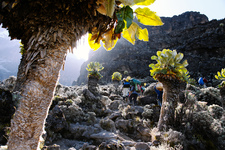MOSHI, Tanzania - Since 1986, Zara Tours has been guiding tourists on treks of Mount Kilimanjaro, Mount Meru, and more. Mount Kilimanjaro has always been sacred to the Maasai people and the snowmelt from the top of this dormant volcano has been watering the valleys below for millions of years.
The mountain is the highest peak in Africa, rising magnificently from the Great Rift Valley to more than 19,300 feet above sea level.
How to prepare for summertime trekking on Mt. Kilimanjaro
Plan for fluctuating weather. Tanzania is near the equator, which places it firmly in the tropics, where there is no such thing as summer and winter. There are only “dry seasons” and rainy periods, or “wet seasons”.
There are two seasons that are best for trekking Mt. Kilimanjaro. They are January-March and June-October. January-March is optimal as the weather is more temperate, not too cold or wet. June-October is drier as well, with many warm days, although the nights on Kilimanjaro can be bitter cold, due to the elevation.
Ready yourself for climbing. Preparation for climbing Mt. Kilimanjaro, known as the “roof of Africa”, is essential. Kilimanjaro is a non-technical mountain, which means that anybody with reasonable fitness can climb it and expensive equipment isn’t required. At the same time, it’s necessary to be in decent shape and good health and to prepare to carry yourself and your gear more than 19,300 feet above sea level.
Nighttime temperatures regularly drop below freezing, so be sure to bring appropriate clothing. Keep in mind that you’ll likely be camping at night, so it’s wise to consider your living preferences and hygiene. It’s essential to remain hydrated, so carry a few one-liter reusable water bottles. Pack thermal leggings, warm fleece pants, and lightweight, quick-drying hiking pants.
Include sunglasses, a warm head cover, and a sun-shading hat. Invest in a good pair of waterproof hiking boots and carry a fresh pair of socks for each day on the mountain. Many hikers also bring hiking poles because the terrain is rocky and steep. Prolonged walking is more physically exhausting at high altitudes, and you may encounter wind, rain, snow, and blazing sun.
Be ready to tip your guides and porters, who could be carrying gear for you and others in the group.
Enjoy viewing the array of wildlife. Tours on Mount Kilimanjaro go through a wide variety of ecological zones: bushland, rainforest, heath, alpine desert, and arctic. As elevation increases, life diversity lessens, and you will see fewer plants, insects, and available water sources. This area is teeming with wildlife, and there have been recordings of over 150 species of mammals on the mountain, including seven primates and hundreds of bird species.
Large mammals have been sighted in the lower elevation areas, such as elephants, giraffes, buffalo, and colobus monkeys. There are also smaller, unique mammals such as porcupines, honey badgers, and aardvarks. Unfortunately with the numbers of humans trekking the mountain, many animals stay away from humans and hide in the surrounding rain forests.
Visit surrounding local attractions. There are many attractions in the area. The land is diverse, as well as the people, and you can do such things as visiting the Materuni Waterfalls and Kikuletwa Hotsprings. Lake Chala is vast and a beautiful place to relax by the water, or you could explore the local culture at Olpopongi in the Maasai Cultural Village & Museum.
Respect the wild places. Respect Mount Kilimanjaro and all the life that surrounds it. Trekking tours improve safety, but the mountain is not to be taken lightly, as people still die climbing it every year. The routes can be arduous and steep, and you can count on hiking four to 15 uphill miles each day, depending on the trail taken.
About ZARA TOURS
Our full-service, multi-award-winning East African travel company owns and operates local hotels, lodges, and wild camps to create a truly amazing adventure-of-a-lifetime. Tanzania, the largest country in East Africa, offers a landscape for every traveler: white beaches on the coast, the Serengeti plains full of wildlife, tropical rain forests full of monkeys and brightly colored birds, and one of the world’s largest mountains, Mt. Kilimanjaro.
With over 30 years of experience, we offer the best in trained climbing guides, accommodations, and safari operators to give a once-in-a-lifetime experience you will want to relive time and again. Find us online at www.zaratours.com and if you wish to contribute to our charities, please find us at www.zaracharitytanzania.org for all the information you’ll need.
Press Contact
Godwin
[email protected]
+1 866 550 4447
Publicity and Marketing Department







